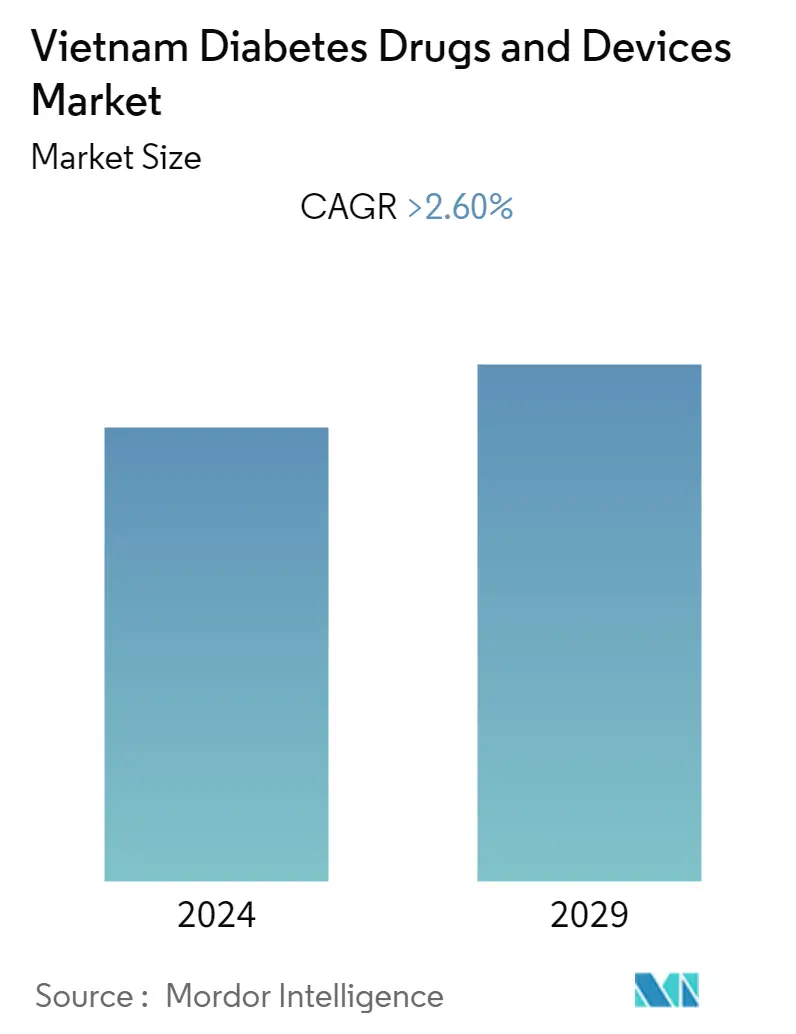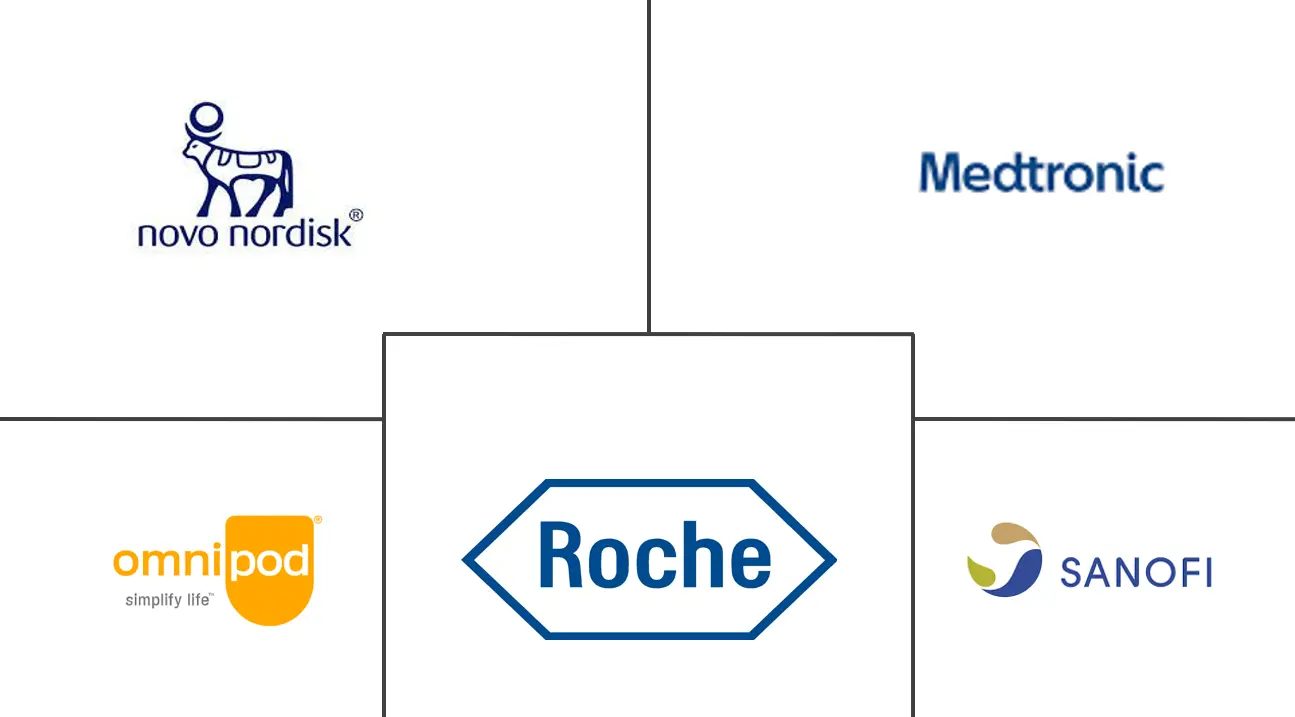Market Size of Vietnam Diabetes Drugs and Devices Industry

| Study Period | 2018 - 2029 |
| Base Year For Estimation | 2023 |
| Forecast Data Period | 2024 - 2029 |
| Historical Data Period | 2018 - 2022 |
| CAGR | > 2.60 % |
Major Players
*Disclaimer: Major Players sorted in no particular order |
Vietnam Diabetes Drugs and Devices Market Analysis
Vietnam's diabetes drugs and devices market size is estimated at USD 0.6 billion in the current year. The market is expected to reach USD 0.7 billion in five years, registering a CAGR of more than 2.6% during the forecast period.
Vietnam has effectively contained the spread of COVID-19 from the outset and has been dead for months. But since then, a fourth wave of the COVID-19 outbreak has wreaked havoc on Vietnam. According to the Ministry of Health (MOH), Vietnam experienced four waves of the COVID-19 outbreak. COVID-19 (coronavirus disease) has been established to be a highly contagious viral infection caused by coronavirus-2, which causes severe acute respiratory syndrome (SARS-CoV-2). Diabetes is a major risk factor for fatal cases of COVID-19. Diabetic patients are susceptible to infections due to comorbidities such as hyperglycemia, immune dysfunction, vascular problems, hypertension, dyslipidemia, and cardiovascular disease. Additionally, in humans, angiotensin-converting enzyme 2 (ACE2) is the SARS-CoV-2 receptor. Therefore, angiotensin-converting enzyme inhibitors (ACE inhibitors) should be used cautiously in diabetic patients. Severity and mortality from COVID-19 were significantly higher in people with diabetes than non-diabetics. Therefore, people with diabetes should be careful during the COVID-19 outbreak.
Vietnam aims for universal health coverage, decentralizing health administration to the lower levels of the country's administrative structure. Each facility in Vietnam creates individual offers using Ministry of Health guidelines for pricing different medicines. These costs were up to six times higher than the global market. The purchase of branded and generic medicines affects the expenditures of institutions in Vietnam and thus affects individuals and the insurance system. Diabetes is considered a public health burden in Vietnam, and health authorities are taking steps to reduce this burden-the diabetes burden in Vietnam results from several epidemiological trends and factors. Diabetes can become an epidemic and pose a huge health and economic burden to Vietnam. Although the prevalence of diabetes in rural areas remains low, it is on the rise. Diabetes is as common in big cities as in other parts of the West. The government of Vietnam's sponsorship increased the usage of managed devices during the forecast period.
Thus, the above factors are expected to drive market growth over the forecast period.
Vietnam Diabetes Drugs and Devices Industry Segmentation
Patients with type 1 diabetes must be given insulin because their pancreas cannot process it. To control blood sugar levels, insulin must be offered several times daily, such as when eating or drinking. Many people with type 2 diabetes also need to take antidiabetic drugs. These drugs include diabetes medications and injections such as insulin. The two main types are traditional blood glucose meters that use a fall of blood to examine what levels are at that instant and continuous glucose monitors (CGMs) that check blood glucose repeatedly day or night. Vietnam Diabetes Drugs and Devices Market is segmented by drugs (insulin, oral anti-diabetic drugs, non-insulin injectable drugs, and combination drugs) and devices (management devices, insulin pumps, insulin pens, syringes, cartridges, jet injectors, monitoring devices, self-monitoring blood and continuous glucose monitoring). The report offers the value (in USD) and volume (in unit) for the above segments.
| Devices | ||||||
| ||||||
|
| Drugs | |
| Oral Anti-Diabetes Drugs | |
| Insulin Drugs | |
| Combination Drugs | |
| Non-Insulin Injectable Drugs |
Vietnam Diabetes Drugs and Devices Market Size Summary
The diabetes drugs and devices market in Vietnam is poised for growth, driven by the increasing prevalence of diabetes and the government's efforts to enhance healthcare coverage. Despite the challenges posed by COVID-19, which has highlighted the vulnerabilities of diabetic patients, Vietnam is focusing on decentralizing health administration and improving access to diabetes care. The market is influenced by the high costs of branded and generic medicines, which impact both healthcare institutions and patients. As diabetes becomes a more significant public health concern, especially in urban areas, the government is promoting the use of managed devices to mitigate the disease's impact. Digital health initiatives, such as those by GlucoMe, are also contributing to better diabetes management, further supporting market expansion.
The economic and social changes in Vietnam are contributing to the rising incidence of diabetes, making it a leading cause of death and disability. The market is characterized by innovation and strategic partnerships among major players like Abbott and Medtronic, who are investing in research and development to enhance insulin delivery devices. Efforts to improve local drug production and access to medicines, as seen in partnerships like that of Viatris and Medochemie, are also pivotal. Additionally, initiatives addressing specific conditions such as gestational diabetes reflect a broader commitment to tackling diabetes-related challenges. These factors collectively indicate a positive outlook for the diabetes drugs and devices market in Vietnam over the forecast period.
Vietnam Diabetes Drugs and Devices Market Size - Table of Contents
-
1. MARKET DYNAMICS
-
1.1 Market Overview
-
1.2 Market Dynamics
-
1.2.1 Market Drivers
-
1.2.2 Market Restraints
-
-
1.3 Porter's Five Forces Analysis
-
1.3.1 Bargaining Power of Suppliers
-
1.3.2 Bargaining Power of Consumers
-
1.3.3 Threat of New Entrants
-
1.3.4 Threat of Substitute Products and Services
-
1.3.5 Intensity of Competitive Rivalry
-
-
-
2. Market Segmentation (Market Size by Value - USD)
-
2.1 Devices
-
2.1.1 Monitoring Devices
-
2.1.1.1 Self-monitoring Blood Glucose Devices
-
2.1.1.2 Continuous Blood Glucose Monitoring
-
-
2.1.2 Management Devices
-
2.1.2.1 Insulin Pump
-
2.1.2.2 Insulin Syringes
-
2.1.2.3 Insulin Cartridges
-
2.1.2.4 Disposable Pens
-
-
-
2.2 Drugs
-
2.2.1 Oral Anti-Diabetes Drugs
-
2.2.2 Insulin Drugs
-
2.2.3 Combination Drugs
-
2.2.4 Non-Insulin Injectable Drugs
-
-
Vietnam Diabetes Drugs and Devices Market Size FAQs
What is the current Vietnam Diabetes Drugs and Devices Market size?
The Vietnam Diabetes Drugs and Devices Market is projected to register a CAGR of greater than 2.60% during the forecast period (2024-2029)
Who are the key players in Vietnam Diabetes Drugs and Devices Market?
Medtronics , Roche, NovoNordisk, Sanofi and Omnipod are the major companies operating in the Vietnam Diabetes Drugs and Devices Market.

